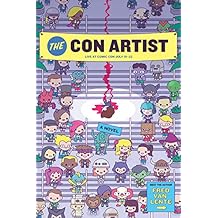There’s no surprise why Fred Van Lente has been called “a popular culture maven”. He’s the No. 1 New York Times best-selling writer of comics like The Amazing Spider-Man, Deadpool vs. the Punisher and Archer & Armstrong. His work has been praised as “some of the funniest material you’ll read in any format” (The Hollywood Reporter) and his debut novel, Ten Dead Comedians (Quirk, 2017), was an Amazon Best of the Month in Mystery, Thriller and Suspense.
He’s now moved on. In The Con Artist (Quirk Books, $14.99), Lente, who has worked in the comic book industry for nearly 20 years, returns with his second novel, a murder mystery set at a comic convention. Comic book artist Mike Mason arrives in San Diego expecting just another comic con, but when his romantic rival turns up dead, Mike becomes the prime suspect.

To clear his name, Mike will have to navigate every corner of the con, from zombie obstacle courses and cosplay flash mobs to intrusive fans and obsessive collectors, in the process unraveling a dark secret behind one of the industry’s most legendary creators.
Featuring illustrations by comics veteran Tom Fowler, and recently described as a “a fun love letter to comic book fans”, The Con Artist perfectly captures the chaotic energy of comic cons and reveals that heroes and villains aren’t just reserved for the pages and panels of our favorite graphic novel.

 She shares the insights and knowledge she’s gained, as well as:
She shares the insights and knowledge she’s gained, as well as:

 No worry if this is the first in the trip you are reading: There are frequent flashbacks, but please do yourself a favor and start at the beginning. Upon this scene stumbles Archie Goldman (previously a teenager in Cousin Joseph), a well-intentioned, if slightly slow, private eye who finds himself increasingly entangled by the tendrils of the Hollywood Blacklist. Plots, counterplots, and general thuggery follow Archie at every turn, and Feiffer casts his story with a wonderful assortment of characters who would not be out of place in a Chandler novel: Lola Burns (a starlet desperate to clear her name and make it in pictures); Lyman Murchison (philanthropist and Red-baiter implicated by a mysterious screenplay called “the Ghost Script”); O.Z. McCay and Faye Bloom (two blacklisted screenwriters seeking revenge); and Miss Know-It-All (a blind gossip columnist with a vicious streak).
No worry if this is the first in the trip you are reading: There are frequent flashbacks, but please do yourself a favor and start at the beginning. Upon this scene stumbles Archie Goldman (previously a teenager in Cousin Joseph), a well-intentioned, if slightly slow, private eye who finds himself increasingly entangled by the tendrils of the Hollywood Blacklist. Plots, counterplots, and general thuggery follow Archie at every turn, and Feiffer casts his story with a wonderful assortment of characters who would not be out of place in a Chandler novel: Lola Burns (a starlet desperate to clear her name and make it in pictures); Lyman Murchison (philanthropist and Red-baiter implicated by a mysterious screenplay called “the Ghost Script”); O.Z. McCay and Faye Bloom (two blacklisted screenwriters seeking revenge); and Miss Know-It-All (a blind gossip columnist with a vicious streak).



